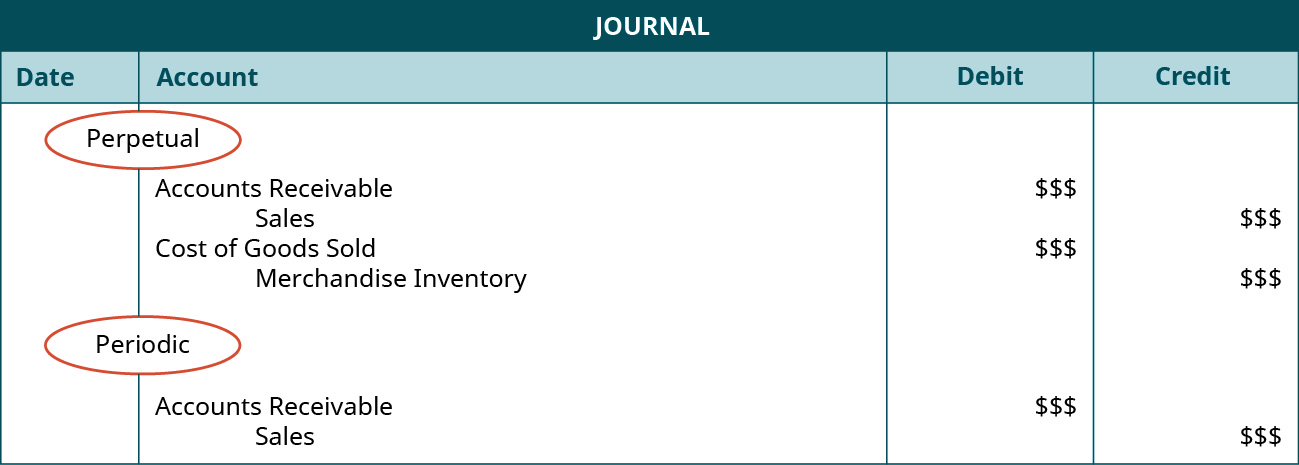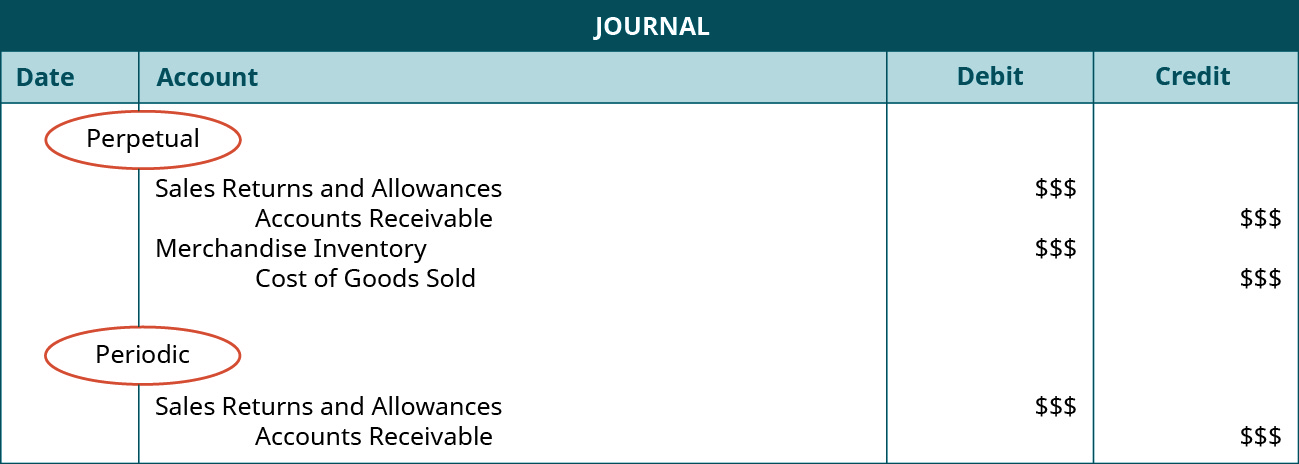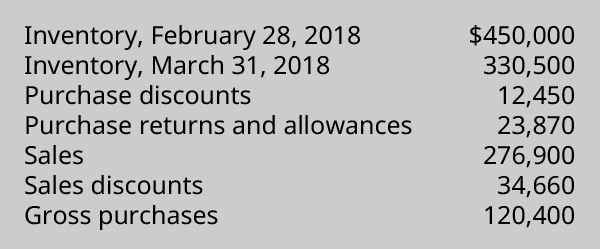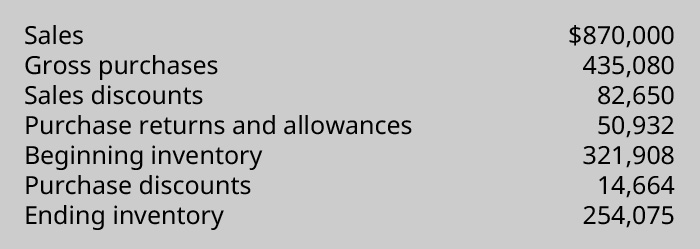The Perpetual Inventory System Is Also Known as What Type of Review System?
Merchandising Transactions
31 Compare and Contrast Perpetual versus Periodic Inventory Systems
There are two ways in which a company may account for their inventory. They can use a perpetual or periodic inventory organisation. Let's look at the characteristics of these two systems.
Characteristics of the Perpetual and Periodic Inventory Systems
A perpetual inventory organisation automatically updates and records the inventory account every fourth dimension a auction, or purchase of inventory, occurs. You can consider this "recording as you become." The recognition of each sale or purchase happens immediately upon auction or purchase.
A periodic inventory system updates and records the inventory account at certain, scheduled times at the end of an operating cycle. The update and recognition could occur at the finish of the month, quarter, and yr. There is a gap between the sale or purchase of inventory and when the inventory action is recognized.
By and large Accepted Accounting Principles (GAAP) do non state a required inventory arrangement, simply the periodic inventory system uses a Purchases account to meet the requirements for recognition under GAAP. IFRS requirements are very similar. The main difference is that avails are valued at net realizable value and tin can be increased or decreased as values change. Under GAAP, in one case values are reduced they cannot be increased again.
Inventory Systems. (credit: "Untitled" past Marcin Wichary/Flickr, CC By 2.0)

Merchandising Transactions
Gearhead Outfitters is a retailer of outdoor-related gear such as clothing, footwear, backpacks, and camping equipment. Therefore, one of the biggest assets on Gearhead'due south remainder sheet is inventory. The proper presentation of inventory in a visitor'south books leads to a number of accounting challenges, such every bit:
- What method of accounting for inventory is advisable?
- How often should inventory be counted?
- How will inventory in the books be valued?
- Is whatever of the inventory obsolete and, if so, how will it be accounted for?
- Is all inventory included in the books?
- Are items included equally inventory in the books that should not be?
Proper application of bookkeeping principles is vital to keep accurate books and records. In accounting for inventory, matching principle, valuation, cutoff, completeness, and cost menstruum assumptions are all important. Did Gearhead lucifer the cost of sale with the sale itself? Was only inventory that belonged to the visitor as of the period finish date included? Did Gearhead count all the inventory? Peradventure some appurtenances were in transit (on a delivery truck for a sale but made, or en route to Gearhead). What is the correct cost menstruum supposition for Gearhead to accurately account for inventory? Should information technology apply a first-in, first-out method, or last-in, first-out?
These are all accounting challenges Gearhead faces with respect to inventory. Equally inventory will represent one of the largest items on the residuum sheet, information technology is vital that Gearhead management take due care with decisions related to inventory accounting. Keeping in listen considerations such equally gross turn a profit, inventory turnover, meeting need, point-of-sale systems, and timeliness of accounting information, what other accounting challenges might arise regarding the company'southward inventory accounting processes?
Inventory Systems Comparison
There are some key differences betwixt perpetual and periodic inventory systems. When a company uses the perpetual inventory organisation and makes a purchase, they will automatically update the Merchandise Inventory account. Nether a periodic inventory system, Purchases will exist updated, while Trade Inventory will remain unchanged until the visitor counts and verifies its inventory balance. This count and verification typically occur at the end of the almanac accounting period, which is often on Dec 31 of the year. The Merchandise Inventory account rest is reported on the balance sheet while the Purchases business relationship is reported on the Income Statement when using the periodic inventory method. The Cost of Appurtenances Sold is reported on the Income Argument under the perpetual inventory method.

A buy return or allowance under perpetual inventory systems updates Merchandise Inventory for whatsoever decreased price. Nether periodic inventory systems, a temporary account, Purchase Returns and Allowances, is updated. Buy Returns and Allowances is a contra business relationship and is used to reduce Purchases.

When a buy discount is applied under a perpetual inventory system, Trade Inventory decreases for the discount amount. Under a periodic inventory organisation, Purchase Discounts (a temporary, contra account), increases for the disbelieve amount and Trade Inventory remains unchanged.

When a sale occurs under perpetual inventory systems, 2 entries are required: ane to recognize the auction, and the other to recognize the toll of sale. For the cost of auction, Merchandise Inventory and Price of Goods Sold are updated. Under periodic inventory systems, this price of sale entry does not be. The recognition of trade toll only occurs at the end of the menstruation when adjustments are made and temporary accounts are closed.

When a sales render occurs, perpetual inventory systems require recognition of the inventory's condition. This ways a decrease to COGS and an increase to Merchandise Inventory. Under periodic inventory systems, but the sales return is recognized, but not the inventory condition entry.

A sales allowance and sales disbelieve follow the same recording formats for either perpetual or periodic inventory systems.

Adjusting and Closing Entries for a Perpetual Inventory System
You have already explored adjusting entries and the closing procedure in prior discussions, just merchandising activities require additional adjusting and endmost entries to inventory, sales discounts, returns, and allowances. Here, we'll briefly hash out these boosted endmost entries and adjustments equally they relate to the perpetual inventory organisation.
At the cease of the menses, a perpetual inventory organization will have the Merchandise Inventory account up-to-appointment; the just thing left to exercise is to compare a concrete count of inventory to what is on the books. A physical inventory count requires companies to practice a manual "stock-bank check" of inventory to make sure what they have recorded on the books matches what they physically accept in stock. Differences could occur due to mismanagement, shrinkage, harm, or outdated merchandise. Shrinkage is a term used when inventory or other assets disappear without an identifiable reason, such equally theft. For a perpetual inventory organization, the adjusting entry to show this divergence follows. This example assumes that the merchandise inventory is overstated in the accounting records and needs to be adjusted down to reflect the actual value on hand.

If a concrete count determines that merchandise inventory is understated in the bookkeeping records, Merchandise Inventory would need to be increased with a debit entry and the COGS would exist reduced with a credit entry. The adjusting entry is:

To sum up the potential aligning process, after the merchandise inventory has been verified with a physical count, its book value is adjusted upward or downward to reflect the actual inventory on hand, with an accompanying adjustment to the COGS.
Non only must an adjustment to Merchandise Inventory occur at the end of a catamenia, but closure of temporary merchandising accounts to set them for the next period is required. Temporary accounts requiring closure are Sales, Sales Discounts, Sales Returns and Allowances, and Price of Goods Sold. Sales volition close with the temporary credit remainder accounts to Income Summary.

Sales Discounts, Sales Returns and Allowances, and Cost of Goods Sold volition shut with the temporary debit balance accounts to Income Summary.

Note that for a periodic inventory organization, the end of the period adjustments require an update to COGS. To decide the value of Toll of Goods Sold, the business will have to look at the beginning inventory balance, purchases, purchase returns and allowances, discounts, and the ending inventory balance.
The formula to compute COGS is:

where:

Once the COGS residuum has been established, an adjustment is fabricated to Merchandise Inventory and COGS, and COGS is closed to prepare for the next catamenia.
(Figure) summarizes the differences between the perpetual and periodic inventory systems.
| Perpetual and Periodic Transaction Comparison | ||
|---|---|---|
| Transaction | Perpetual Inventory System | Periodic Inventory Organisation |
| Buy of Inventory | Record cost to Inventory business relationship | Record toll to Purchases account |
| Purchase Return or Assart | Tape to update Inventory | Record to Buy Returns and Allowances |
| Purchase Discount | Record to update Inventory | Tape to Purchase Discounts |
| Sale of Merchandise | Record two entries: one for sale and 1 for cost of sale | Tape ane entry for the auction |
| Sales Render | Record two entries: one for sales render, one for cost of inventory returned | Tape one entry: sales render, price not recognized |
| Sales Assart | Aforementioned nether both systems | Aforementioned under both systems |
| Sales Discount | Aforementioned under both systems | Aforementioned under both systems |
There are advantages and disadvantages to both the perpetual and periodic inventory systems.
Point-of-Auction Systems
Advancements in point-of-sale (POS) systems accept simplified the in one case tedious job of inventory management. POS systems connect with inventory management programs to make real-time information bachelor to help streamline business operations. The toll of inventory direction decreases with this connection tool, allowing all businesses to stay current with technology without "breaking the bank."
1 such POS arrangement is Square. Square accepts many payment types and updates bookkeeping records every time a sale occurs through a cloud-based application. Foursquare, Inc. has expanded their product offerings to include Square for Retail POS. This enhanced product allows businesses to connect sales and inventory costs immediately. A business can hands create purchase orders, develop reports for price of goods sold, manage inventory stock, and update discounts, returns, and allowances. With this application, customers accept payment flexibility, and businesses can make present decisions to positively affect growth.
Advantages and Disadvantages of the Perpetual Inventory System
The perpetual inventory system gives real-fourth dimension updates and keeps a abiding period of inventory information available for determination-makers. With advancements in point-of-auction technologies, inventory is updated automatically and transferred into the company's accounting system. This allows managers to make decisions as it relates to inventory purchases, stocking, and sales. The data can be more robust, with verbal purchase costs, sales prices, and dates known. Although a periodic concrete count of inventory is still required, a perpetual inventory system may reduce the number of times concrete counts are needed.
The biggest disadvantages of using the perpetual inventory systems arise from the resource constraints for cost and time. It is costly to keep an automatic inventory organization up-to-date. This may prohibit smaller or less established companies from investing in the required technologies. The time delivery to train and retrain staff to update inventory is considerable. In add-on, since there are fewer concrete counts of inventory, the figures recorded in the system may be drastically dissimilar from inventory levels in the bodily warehouse. A visitor may non accept correct inventory stock and could make financial decisions based on incorrect data.
Advantages and Disadvantages of the Periodic Inventory Organisation
The periodic inventory system is often less expensive and time consuming than perpetual inventory systems. This is because in that location is no constant maintenance of inventory records or grooming and retraining of employees to upkeep the system. The complication of the system makes it difficult to identify the cost justification associated with the inventory function.
While both the periodic and perpetual inventory systems require a concrete count of inventory, periodic inventorying requires more than concrete counts to be conducted. This updates the inventory account more frequently to tape exact costs. Knowing the exact costs earlier in an bookkeeping bicycle can help a company stay on budget and control costs.
All the same, the need for frequent concrete counts of inventory can append business operations each fourth dimension this is done. At that place are more chances for shrinkage, damaged, or obsolete merchandise because inventory is not constantly monitored. Since there is no constant monitoring, information technology may exist more difficult to make in-the-moment business decisions virtually inventory needs.
While each inventory system has its own advantages and disadvantages, the more than pop system is the perpetual inventory system. The ability to take real-time data to make decisions, the constant update to inventory, and the integration to point-of-sale systems, outweigh the price and fourth dimension investments needed to maintain the organization. (While our main coverage focuses on recognition under the perpetual inventory system, Appendix: Clarify and Tape Transactions for Merchandise Purchases and Sales Using the Periodic Inventory System discusses recognition under the periodic inventory system.)
Comparing Inventory Systems
Your company uses a perpetual inventory system to control its operations. They only check inventory in one case every 6 months. At the 6-calendar month concrete count, an employee notices several inventory items missing and many damaged units. In the company records, information technology shows an inventory balance of $300,000. The actual physical count values inventory at $200,000. This is a pregnant difference in valuation and has jeopardized the future of the company. As a manager, how might you lot avoid this large discrepancy in the futurity? Would a change in inventory systems benefit the company? Are you constrained by whatsoever resource?
Key Concepts and Summary
- A perpetual inventory system inventory updates purchase and sales records constantly, particularly impacting Merchandise Inventory and Cost of Goods Sold.
- A periodic inventory system only records updates to inventory and costs of sales at scheduled times throughout the yr, not constantly. Trade Inventory and Cost of Appurtenances Sold are updated at the finish of a menstruum.
- Cost of goods sold (COGS) includes all elements of price related to the sale of merchandise. The formula to determine COGS if one is using the periodic inventory organisation, is Beginning Inventory + Cyberspace Purchases – Ending Inventory.
- The perpetual inventory arrangement keeps real-time data and the information is more robust. However, it is plush and fourth dimension consuming, and concrete counts of inventory are deficient.
- With the periodic inventory system, there are more than frequent inventory counts and reduced chances for shrinkage and damaged merchandise. Yet, the periodic system makes it difficult for businesses to keep track of inventory costs and to make nowadays decisions about their business.
Multiple Choice
(Effigy)Which of the following is a disadvantage of the perpetual inventory system?
- Inventory information is in real-time.
- Inventory is automatically updated.
- Information technology allows managers to brand current decisions about purchases, stock, and sales.
- It is cost-prohibitive.
(Figure)Which of the following is an advantage of the periodic inventory arrangement?
- frequent physical inventory counts
- toll prohibitive
- time consuming
- real-time information for managers
(Figure)Which of the following is not a reason for the physical inventory count to differ from what is recognized on the company'south books?
- mismanagement
- shrinkage
- damage
- sale of services to customers
(Figure)Which of the following is not included when calculating Net Purchases?
- purchase discounts
- starting time inventory
- purchase returns
- buy allowances
Questions
(Figure)What are 2 advantages and disadvantages of the perpetual inventory system?
Advantages could include existent-time information and more robust information. Disadvantages could include fewer inventory counts with opportunity for mismanagement of inventory. It is too costly, and time consuming.
(Figure)What are two advantages and disadvantages of the periodic inventory system?
(Figure)Sunrise Flowers sells flowers to a customer on credit for $130 on October 18, with a cost of auction to Sunrise of $fifty. What entry to recognize this sale is required if Sunrise Flowers uses a periodic inventory system?
| October 18 | Accounts Receivable | 130 | |
| Sales | 130 | ||
| To recognize sale under periodic inventory system | |||
| Note: No cost of auction entry is required currently, only at the end of the period nether periodic. | |||
(Figure)Sunrise Flowers sells flowers to a client on credit for $130 on October xviii, with a cost of sale to Sunrise of $50. What entry to recognize this auction is required if Sunrise Flowers uses a perpetual inventory organization?
Exercise Set A
(Figure)The post-obit is selected information from Mars Corp. Compute cyberspace purchases, and cost of goods sold for the month of March.

(Figure)On Apr five, a client returns 20 bicycles with a sales price of $250 per bike to Barrio Bikes. Each bike cost Barrio Bikes $100. The client had however to pay on their account. The bikes are in sellable condition. Prepare the journal entry or entries to recognize this return if the company uses
- the perpetual inventory system
- the periodic inventory organization
Exercise Fix B
(Figure)The post-obit is selected information from Orange Industries. Compute net purchases, and cost of goods sold for the month of June.

(Figure)On Apr 20, Barrio Bikes purchased 30 bicycles at a toll of $100 per bike. Credit terms were 4/10, n/thirty, with an invoice date of Apr 20. On April 26, Barrio Bikes pays in full for the purchase. Prepare the periodical entry or entries to recognize the purchase and subsequent payment if Barrio Bikes uses:
- the perpetual inventory organization
- the periodic inventory system
Trouble Set A
(Figure)Costume Warehouse sells costumes and accessories. Review the following transactions and prepare the periodical entry or entries if Costume Warehouse uses:
- the perpetual inventory system
- the periodic inventory system
| May 3 | A customer purchases 45 costumes at a sales cost of $35 per costume. The cost to Costume Warehouse per costume is $15. The terms of the sale are iii/15, n/60, with an invoice date of May iii. |
| May x | The customer who fabricated the May 3 purchase returns five of the costumes to the store for a total refund, claiming they were the wrong size. The costumes were returned to Costume Warehouse's inventory at $15 per costume. |
| May 16 | The customer pays in total for the remaining costumes, less the return. |
(Figure)Pharmaceutical Supplies sells medical supplies to customers. Review the post-obit transactions and ready the journal entry or entries if Pharmaceutical Supplies uses:
- the perpetual inventory organization
- the periodic inventory system
| Jul. 9 | A customer purchases fifty pairs of crutches at a sales price of $20 per pair. The cost to Pharmaceutical Supplies per pair is $eight.00. The terms of the auction are 5/10, n/thirty, with an invoice date of July 9. |
| Jul. 12 | The client who made the July nine purchase returns nine of the pairs to the store for a total refund, claiming they were the wrong size. The crutch pairs were returned to the store's inventory at $eight.00 per pair. |
| Jul. 18 | The customer pays in full for the remaining crutches, less the return. |
Trouble Prepare B
(Figure)Costume Warehouse sells costumes and accessories and purchases their trade from a manufacturer. Review the following transactions and prepare the periodical entry or entries if Costume Warehouse uses
- the perpetual inventory organization
- the periodic inventory system
| Jun. 4 | Costume Warehouse purchases 88 costumes on credit at a purchase price of $fifteen per costume. The terms of the purchase are 5/xv, n/30, with an invoice date of June 4. |
| Jun. 12 | Costume Warehouse returns 20 costumes to the manufacturer for a full refund. |
| Jun. 19 | Costume Warehouse pays in total for the remaining costumes, less the render. |
(Effigy)Pharmaceutical Supplies sells medical supplies and purchases their merchandise from a manufacturer. Review the following transactions and prepare the journal entry or entries if Pharmaceutical Supplies uses
- the perpetual inventory system
- the periodic inventory system
| Apr. 7 | Pharmaceutical Supplies purchases l medical stands on credit at a buy toll of $xv per stand. The terms of the purchase are 5/ten, n/45, with an invoice engagement of Apr 7. |
| April. 11 | Pharmaceutical Supplies returns eighteen stands to the manufacturer for a total refund. |
| April. 17 | Pharmaceutical Supplies pays in full for the remaining stands, less the return. |
Thought Provokers
(Effigy)You have decided to open up upward a small convenience store in your hometown. As part of the initial set-up process, y'all need to determine whether to use a perpetual inventory system or a periodic inventory arrangement. Write an evaluation paper comparing the perpetual and periodic inventory systems. Describe the benefits and challenges of each system every bit it relates to your industry and to your business size. Compare at least ane example transaction using the perpetual and periodic inventory systems (a purchase transaction, for example). Research and depict the impact each system has on your financial statements. Determine which system would exist the best fit for your business, and support your decision with research.
Glossary
- periodic inventory organization
- updates and records the inventory business relationship at certain, scheduled times at the end of an operating bicycle
- perpetual inventory arrangement
- system that automatically updates and records the inventory account every time a auction or purchase of inventory occurs
- physical inventory count
- transmission stock check of inventory to make sure what is recorded on the books matches what is actually in the warehouse and on the sales floor
Source: https://opentextbc.ca/principlesofaccountingv1openstax/chapter/compare-and-contrast-perpetual-versus-periodic-inventory-systems/
Postar um comentário for "The Perpetual Inventory System Is Also Known as What Type of Review System?"